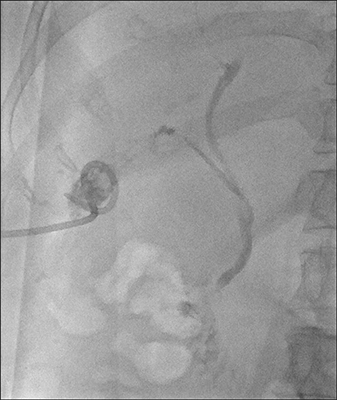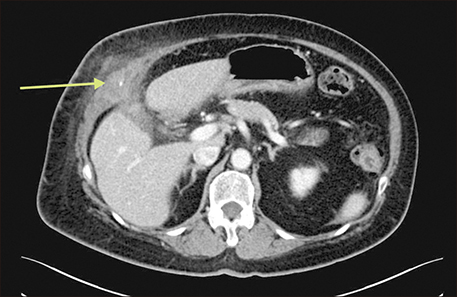Ann Hepatobiliary Pancreat Surg.
2019 May;23(2):197-199. 10.14701/ahbps.2019.23.2.197.
Ectopic retained gallstone causing an abdominal wall abscess
- Affiliations
-
- 1Department of General Surgery, Tan Tock Seng Hospital, Singapore. Vishal_G_Shelat@ttsh.com.sg
- KMID: 2448777
- DOI: http://doi.org/10.14701/ahbps.2019.23.2.197
Abstract
- A 67-year-old lady was managed with percutaneous cholecystostomy for severe acute cholecystitis with septic shock. An interval laparoscopic subtotal cholecystectomy was done at 8 weeks. Her post-operative phase was complicated by intra-abdominal abscess requiring radiologically guided percutaneous drain insertion. Five days following the removal of the drain, she presented with a right abdominal wall abscess. A computerized tomography scan showed an abdominal wall ectopically-retained gallstone. The gallstone was retrieved along with drainage of abscess.
MeSH Terms
Figure
Reference
-
1. Grass F, Fournier I, Bettschart V. Abdominal wall abscess after cholecystectomy. BMC Res Notes. 2015; 8:334.
Article2. Hand AA, Self ML, Dunn E. Abdominal wall abscess formation two years after laparoscopic cholecystectomy. JSLS. 2006; 10:105–107.3. Woodfield JC, Rodgers M, Windsor JA. Peritoneal gallstones following laparoscopic cholecystectomy: incidence, complications, and management. Surg Endosc. 2004; 18:1200–1207.4. Yeo CS, Tay VW, Low JK, Woon WW, Punamiya SJ, Shelat VG. Outcomes of percutaneous cholecystostomy and predictors of eventual cholecystectomy. J Hepatobiliary Pancreat Sci. 2016; 23:65–73.
Article5. Shelat VG, Chia CL, Yeo CS, Qiao W, Woon W, Junnarkar SP. Pyogenic liver abscess: does escherichia coli cause more adverse outcomes than klebsiella pneumoniae? World J Surg. 2015; 39:2535–2542.
Article6. Sathesh-Kumar T, Saklani AP, Vinayagam R, Blackett RL. Spilled gall stones during laparoscopic cholecystectomy: a review of the literature. Postgrad Med J. 2004; 80:77–79.
Article7. Amirthalingam V, Low JK, Woon W, Shelat V. Tokyo Guidelines 2013 may be too restrictive and patients with moderate and severe acute cholecystitis can be managed by early cholecystectomy too. Surg Endosc. 2017; 31:2892–2900.
Article8. Horn T, Christensen SD, Kirkegård J, Larsen LP, Knudsen AR, Mortensen FV. Percutaneous cholecystostomy is an effective treatment option for acute calculous cholecystitis: a 10-year experience. HPB (Oxford). 2015; 17:326–331.
Article9. Nasim S, Khan S, Alvi R, Chaudhary M. Emerging indications for percutaneous cholecystostomy for the management of acute cholecystitis--a retrospective review. Int J Surg. 2011; 9:456–459.10. Sartelli M, Labricciosa FM, Barbadoro P, Pagani L, Ansaloni L, Brink AJ, et al. The global alliance for infections in surgery: defining a model for antimicrobial stewardship-results from an international cross-sectional survey. World J Emerg Surg. 2017; 12:34.




